SCHEME OF WORK
WEEK TOPIC
1. Meaning and objectives of physical and health (a) Meaning of (i) Physical Education (ii) Health Education (b) Scope of Physical Education – Instructional level, Intramural level, Inter-collegiate level.
2. Scope of Health Education – Personal, School, Community, Industrial and Occupational ((d) objectives of Physical and Health Education: (i) physical development (ii) mental development (iii) social and emotional development.
3. History and Development of Physical and Health Education (a) Pre-colonial physical education (b) History of formal physical education in Nigeria (c) Development of physical education in Nigeria (d) History of health education in Nigeria (e) Development of health education in Nigeria.
4. Field Events: (a) Pole vault skills – grip, pole carrying run-up, take off, hang, swing, pull-up and turn, push-up and clearance. (b) Throws- Basic throwing skills in discus and shot put- grip, stance, throw, release, follow through the sector.
5. Ball Games: (a) History and development of Volleyball and Soccer. (b) Basic skills and techniques of the games. (c) Application of rules and regulations governing the games.
6. Ball Games: (d) Officials of the games and their functions. (e) Facilities and equipment. (f) Values of ball games. (g) court/pitch specifications (dimensions).
7. Pre-colonial Sport/Traditional Sports: (a) Types of traditional sports. (i) Boat regatta (ii) Local wrestling (iii) Abula (iv) Langa (b) Origin and significance of pre- colonial sports.
8. Pre-Colonial Sport/Traditional Sports: (c) Description, facilities, equipment, rules, regulations, techniques, and officials of traditional sports (Boat regatta, Local wrestling,-kokowa ,ijakadi) (d) Description, facilities, equipment, rules, regulations, techniques and officials of Abula. (e) Description, facilities, equipment, rules, regulations, techniques and officials of Langa.
9. Revision.
1ST TERM
WEEK 1
LESSON 1
Topic: Meaning of Physical education:
Physical Education is an integral part of the total process of education that make use of selected and properly conducted physical activities in the development and maintenance of the whole individual. Physical Education is the education that is concerned with the physical development of a person but it does not develop the body alone, it also develops other areas of human life.

Meaning of Health Education:
Health Education consists of all leaning experiences which influence the individual’s knowledge, habits and attitudes towards the promotion and maintenance of ones health, that of the family and the community.
“Health” as defined by World Health Organization (WHO). ‘Health is a state of complete physical, mental and social well being of an individual and not merely the absence of disease or infirmity.

Scope of Physical Education.
Physical Education covers a wide area which includes games, athletics, physical training, dancing, free play, camping, mountaineering, sailing, aquatics, gymnastics, skiing. etc. At the higher levers of education , physical education include anatomy and physiology, psychology, kinesiology, history and sociology of sports, other areas include sports medicine and music.
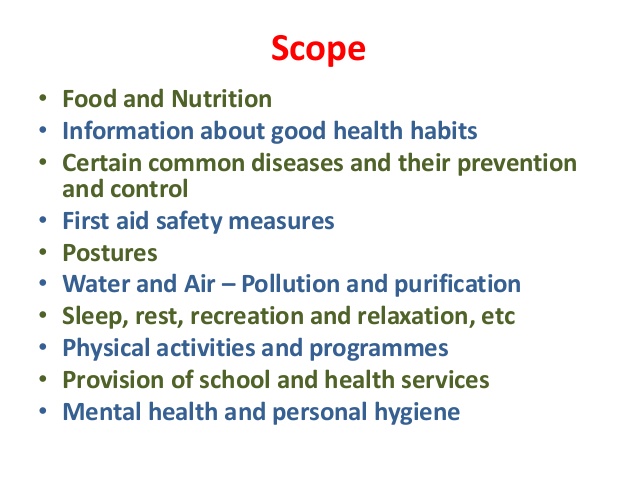
Topic: Meaning of Physical education:
Physical Education is an integral part of the total process of education that make use of selected and properly conducted physical activities in the development and maintenance of the whole individual. Physical Education is the education that is concerned with the physical development of a person but it does not develop the body alone, it also develops other areas of human life.

Meaning of Health Education:
Health Education consists of all leaning experiences which influence the individual’s knowledge, habits and attitudes towards the promotion and maintenance of ones health, that of the family and the community.
“Health” as defined by World Health Organization (WHO). ‘Health is a state of complete physical, mental and social well being of an individual and not merely the absence of disease or infirmity.

Scope of Physical Education.
Physical Education covers a wide area which includes games, athletics, physical training, dancing, free play, camping, mountaineering, sailing, aquatics, gymnastics, skiing. etc. At the higher levers of education , physical education include anatomy and physiology, psychology, kinesiology, history and sociology of sports, other areas include sports medicine and music.

WEEK 2
LESSON 2
Topic: Scope and objectives of physical and Health Education.
Content: (a) Scope of Health Education.
(b) Objectives of physical and health Education.
Scope of health Education.
Health education exposes students to skills, knowledge and attitude that help them to keep body safe and healthy. Health education therefore covers areas like safety and first aid, drug education community health, consumer health, diseases, environmental health, sex education, food and nutrition, personal health and family planning.

Objectives of physical and Health Education
(i) Physical development; i.e. helps to develop the muscle of the body through selected activities.
(ii) Development of Emotional, Social and Moral fitness: Physical education contributes greatly
in controlling the individual’s feeling of anger, hostility and aggression both in sports and in our
daily lives.
(iii) Development of the wise use of leisure time.
(iv) Development of motor and safety skills.
(v) Intellectual development
(vi) Development of acceptable health habits

Topic: Scope and objectives of physical and Health Education.
Content: (a) Scope of Health Education.
(b) Objectives of physical and health Education.
Scope of health Education.
Health education exposes students to skills, knowledge and attitude that help them to keep body safe and healthy. Health education therefore covers areas like safety and first aid, drug education community health, consumer health, diseases, environmental health, sex education, food and nutrition, personal health and family planning.

Objectives of physical and Health Education
(i) Physical development; i.e. helps to develop the muscle of the body through selected activities.
(ii) Development of Emotional, Social and Moral fitness: Physical education contributes greatly
in controlling the individual’s feeling of anger, hostility and aggression both in sports and in our
daily lives.
(iii) Development of the wise use of leisure time.
(iv) Development of motor and safety skills.
(v) Intellectual development
(vi) Development of acceptable health habits

WEEK 3
LESSON 3
Topic: History and development of physical and health education.
Content: (a) Pre-colonial physical education.
(b) History of formal physical education in Nigeria
(c) Development of physical education in Nigeria
Pre-colonial Physical Education
The history of physical education in Nigeria is as old as Nigeria. As various communities settled down to life, they engaged in various forms of physical activities consciously and unconsciously. They engaged in activities such as horse riding, canoeing, fishing, hunting, trees climbing, dancing and wrestling. The use of bow and arrow, moon light games, hide and seek games for children and swimming were other activities performed by the early Nigerians.

History of formal physical education in Nigeria
Modern PHE started when the colonial masters and Christian missionaries came to Nigeria. The aim was to develop fitness for police and others. School was seen as the best stadium where this philosophy could be easily passed across. The trend of development of PHE in Nigeria followed a systematic movement from the informal, unorganized pattern to when PHE was organized in form of physical training and military drills. It was aimed at training a strong and disciplined individual.
Development of physical education in Nigeria
The first recorded sports / games competition was held in December 24th 1884.It was organized by the Lagos Education Board to mark the close of the school year with athletics and dance. Henry Carl suggested children should be trained to be kind , gentle and occupied to protect them from the streets.
A Physical and Health Education syllabus was developed to replace military drills in 1904. In 1919 and 1933, the syllabus was revised. PHE started as a course of higher learning in Nigeria college of Arts, Science and Technology, Zaria ( which became Ahmadu Bello University later).
The first indigenous syllabus was introduced in 1945 by H. Ekperiegin. Today, Physical Education is offered as a course of study up to the PHD level in many universities in Nigeria and there are many professors of physical and health education such as Professors Ajisafe, Omoruah, Adedeji, Eboh, Morakinyo, Ikulayo and many more. The Promulgation of decree No 34 of 1971 by the military regime to establish the National Sports Commission helped to boost physical education. It is now known that through physical education, sporting skills are developed.
The Nigerian Association for PHE is NAPHER-SD meaning Nigeria Association for Physical, Health Education and Recreation-Sports and Dance.

Evaluation
1. State 3 Pioneers of PHE in Nigeria.
2. What are the differences between traditional and modern PHE ?
Reading Assignment:
Essential of PHE for Junior Secondary School book 1 by Akinseye Saint Erazmus, PP 8-10
Objective Test
1. One of the following was not an activity of ancient PHE (a)wrestling (b) fighty (c) hunting
2. Ancient Olympic was revived by (a)Plato (b) Baron Pierre of Nigeria (c) Baron Pierre de coubet
3. One of these introduced the first lndigenous syllabus in 1945 (a)Ekperigin (b) Okocha (c) Adedeji.
Theory
1. Briefly describe the development of PHE in Nigeria.
2.Who is Henry Carl?
Topic: History and development of physical and health education.
Content: (a) Pre-colonial physical education.
(b) History of formal physical education in Nigeria
(c) Development of physical education in Nigeria
Pre-colonial Physical Education
The history of physical education in Nigeria is as old as Nigeria. As various communities settled down to life, they engaged in various forms of physical activities consciously and unconsciously. They engaged in activities such as horse riding, canoeing, fishing, hunting, trees climbing, dancing and wrestling. The use of bow and arrow, moon light games, hide and seek games for children and swimming were other activities performed by the early Nigerians.

History of formal physical education in Nigeria
Modern PHE started when the colonial masters and Christian missionaries came to Nigeria. The aim was to develop fitness for police and others. School was seen as the best stadium where this philosophy could be easily passed across. The trend of development of PHE in Nigeria followed a systematic movement from the informal, unorganized pattern to when PHE was organized in form of physical training and military drills. It was aimed at training a strong and disciplined individual.
Development of physical education in Nigeria
The first recorded sports / games competition was held in December 24th 1884.It was organized by the Lagos Education Board to mark the close of the school year with athletics and dance. Henry Carl suggested children should be trained to be kind , gentle and occupied to protect them from the streets.
A Physical and Health Education syllabus was developed to replace military drills in 1904. In 1919 and 1933, the syllabus was revised. PHE started as a course of higher learning in Nigeria college of Arts, Science and Technology, Zaria ( which became Ahmadu Bello University later).
The first indigenous syllabus was introduced in 1945 by H. Ekperiegin. Today, Physical Education is offered as a course of study up to the PHD level in many universities in Nigeria and there are many professors of physical and health education such as Professors Ajisafe, Omoruah, Adedeji, Eboh, Morakinyo, Ikulayo and many more. The Promulgation of decree No 34 of 1971 by the military regime to establish the National Sports Commission helped to boost physical education. It is now known that through physical education, sporting skills are developed.
The Nigerian Association for PHE is NAPHER-SD meaning Nigeria Association for Physical, Health Education and Recreation-Sports and Dance.

Evaluation
1. State 3 Pioneers of PHE in Nigeria.
2. What are the differences between traditional and modern PHE ?
Reading Assignment:
Essential of PHE for Junior Secondary School book 1 by Akinseye Saint Erazmus, PP 8-10
Objective Test
1. One of the following was not an activity of ancient PHE (a)wrestling (b) fighty (c) hunting
2. Ancient Olympic was revived by (a)Plato (b) Baron Pierre of Nigeria (c) Baron Pierre de coubet
3. One of these introduced the first lndigenous syllabus in 1945 (a)Ekperigin (b) Okocha (c) Adedeji.
Theory
1. Briefly describe the development of PHE in Nigeria.
2.Who is Henry Carl?
WEEK 4
LESSON 4
Topic: Athletics
Content: (a) Meaning and History of Athletics
(b) Field Event (Throws and Jumps)
(c) Pole Vault – skills and techniques.
(d) Discuss and shot put – skills and techniques.
Meaning and History Of Athletics
Athletics: means running on a flat surface or over obstacles. Athletics include track and field event.
History – Athletics actually began during the time of early men when they were forced to run , jump, climb trees and mountains, throw sticks and stones, swim, dance and wrestle in order to obtain their food or to protect their lives from dangers. The first organized athletics meeting was held in 776 B.C. It was known as Olympic games. It comes up every four years. In 394 A.D, Emperor Theodosus banned the festival i.e. Olympic games but it was revived in 1896 by Baron Pierre de Coubertin- a French lover of sports who is known as the father of modern Olympics.

The International Amateur Athletics Federation (I.A.A.F) with its headquarters in London is the international body that regulates the rules of Athletics. The modern form of athletics in Nigeria was brought by the colonial masters in 1944, the Athletics federation of Nigeria was formed. Presently the body responsible for the control and regulation of the Game is A.A.A.N – Amateur Athletics Association of Nigeria.
Athletics is divided into 2 major groups: (i) Track events and (ii) Field events
Field Events:
Field events consist of the jumps and the throws. The Jumps involve vertical and horizontal. The vertical jumps are high jump, pole vault while horizontal (distance) jumps are long jump and triple jump.
There are four throwing events. They are shot put, discus, javelin and hammer.

Evaluation
1. What is Athletics?
2. List the two division of Athletics with examples.
LESSON 5
Pole Vault
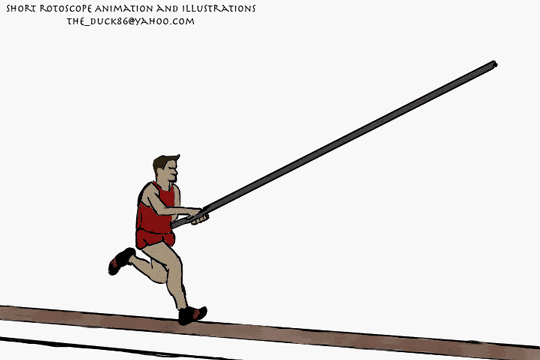
Pole vaults skills and techniques - Pole vault is a field events which involves jumping over a horizontally placed obstacles (bar) that is supported by two uprights. The competitor is called a Pole-vaulter. It is a sporting event performed by both male and female athletics. A pole-vaulter should possess the following qualities:-
(i) Flexibility,
(ii) Agility,
(iii) Speed,
(iv) Concentration,
(v) Determination,
(vi) Muscular strength and
(vii) Courage.
Skills in Pole Vault
1. The grip
2. Pole Carryings
3. Run Up
4. Take off
5. Hang
6. Swing Up
7. Pull Up and Turn
8. Clearance and landing
Discus
Discus is a field event which involves throwing a missile called discuss for a horizontal distance. A competitor is allowed three trials, the throwing is made from within a throwing circle of 2.50m to a landing sector of 40o.

Discus Sector.
Basic Skills of Discus
i. Grip
ii. Stance
iii. Throws
iv. Release
v. Follow through the sector
vi. Recovery
Note:- The discus must land within the landing sector which is 40o and both legs must be behind the metal rim.
Shot Put
Shot put is a field event that involve the putting of a missile called the sector for a horizontal distance. A competitor is allowed three trials. The put is made from within a circle of 2.135m to a landing sector of 40o.

Shot put sector.
Basic Skills of Shot Put
a. The hold
b. The stance
c. The Glide
d. The Put or Delivering
e. The Finish or Recovery
The types of putting the Shot
1. The standing put
2. The side shift put
3. The drive or glide.
Note that the shot must land within the landing sector.
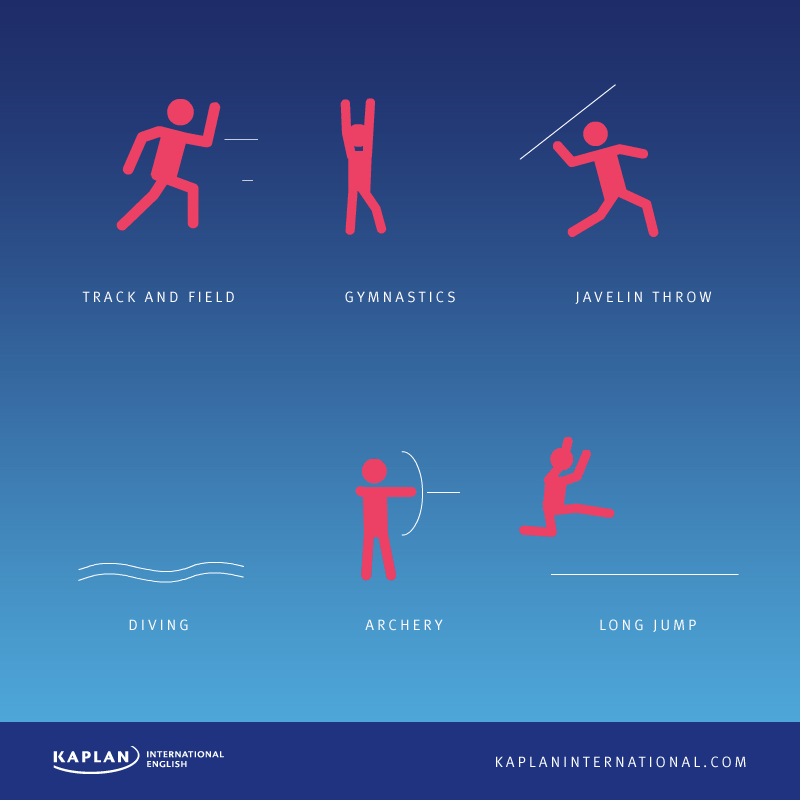
Evaluation
1. Differentiate between Pole Vault and shot put.
2. State two similarities between shot put and discus.
3. Mention 3 quality of a pole-vaulter.
Reading Assignment
Essentials of PHE for junior secondary schools book I by Akinseye S.E.pp.24-27.
Assignment
1.The landing sector for discuss and shot put is (a) 60o (b) 50o (c) 40o
2. One of these is not a quality of a pole-vaulter (a) speed (b) Academic ability (c) Flexibility.
3. Field events involve jumps and throws. (a) Yes (b) No (c) No idea.
4. Running over obstacles or flat surface is called (a) Running race (b) Athletics (c) Field game
5. All the following are field events except (a) Hurdles (b) High jump (c) Pole vaults.
Theories
1. List the skills of discuss
2. Draw and label the shot put landing sector.
Topic: Athletics
Content: (a) Meaning and History of Athletics
(b) Field Event (Throws and Jumps)
(c) Pole Vault – skills and techniques.
(d) Discuss and shot put – skills and techniques.
Meaning and History Of Athletics
Athletics: means running on a flat surface or over obstacles. Athletics include track and field event.
History – Athletics actually began during the time of early men when they were forced to run , jump, climb trees and mountains, throw sticks and stones, swim, dance and wrestle in order to obtain their food or to protect their lives from dangers. The first organized athletics meeting was held in 776 B.C. It was known as Olympic games. It comes up every four years. In 394 A.D, Emperor Theodosus banned the festival i.e. Olympic games but it was revived in 1896 by Baron Pierre de Coubertin- a French lover of sports who is known as the father of modern Olympics.

The International Amateur Athletics Federation (I.A.A.F) with its headquarters in London is the international body that regulates the rules of Athletics. The modern form of athletics in Nigeria was brought by the colonial masters in 1944, the Athletics federation of Nigeria was formed. Presently the body responsible for the control and regulation of the Game is A.A.A.N – Amateur Athletics Association of Nigeria.
Athletics is divided into 2 major groups: (i) Track events and (ii) Field events
Field Events:
Field events consist of the jumps and the throws. The Jumps involve vertical and horizontal. The vertical jumps are high jump, pole vault while horizontal (distance) jumps are long jump and triple jump.
There are four throwing events. They are shot put, discus, javelin and hammer.

Evaluation
1. What is Athletics?
2. List the two division of Athletics with examples.
LESSON 5
Pole Vault

Pole vaults skills and techniques - Pole vault is a field events which involves jumping over a horizontally placed obstacles (bar) that is supported by two uprights. The competitor is called a Pole-vaulter. It is a sporting event performed by both male and female athletics. A pole-vaulter should possess the following qualities:-
(i) Flexibility,
(ii) Agility,
(iii) Speed,
(iv) Concentration,
(v) Determination,
(vi) Muscular strength and
(vii) Courage.
Skills in Pole Vault
1. The grip
2. Pole Carryings
3. Run Up
4. Take off
5. Hang
6. Swing Up
7. Pull Up and Turn
8. Clearance and landing
Discus
Discus is a field event which involves throwing a missile called discuss for a horizontal distance. A competitor is allowed three trials, the throwing is made from within a throwing circle of 2.50m to a landing sector of 40o.

Discus Sector.
Basic Skills of Discus
i. Grip
ii. Stance
iii. Throws
iv. Release
v. Follow through the sector
vi. Recovery
Note:- The discus must land within the landing sector which is 40o and both legs must be behind the metal rim.
Shot Put
Shot put is a field event that involve the putting of a missile called the sector for a horizontal distance. A competitor is allowed three trials. The put is made from within a circle of 2.135m to a landing sector of 40o.

Shot put sector.
Basic Skills of Shot Put
a. The hold
b. The stance
c. The Glide
d. The Put or Delivering
e. The Finish or Recovery
The types of putting the Shot
1. The standing put
2. The side shift put
3. The drive or glide.
Note that the shot must land within the landing sector.

Evaluation
1. Differentiate between Pole Vault and shot put.
2. State two similarities between shot put and discus.
3. Mention 3 quality of a pole-vaulter.
Reading Assignment
Essentials of PHE for junior secondary schools book I by Akinseye S.E.pp.24-27.
Assignment
1.The landing sector for discuss and shot put is (a) 60o (b) 50o (c) 40o
2. One of these is not a quality of a pole-vaulter (a) speed (b) Academic ability (c) Flexibility.
3. Field events involve jumps and throws. (a) Yes (b) No (c) No idea.
4. Running over obstacles or flat surface is called (a) Running race (b) Athletics (c) Field game
5. All the following are field events except (a) Hurdles (b) High jump (c) Pole vaults.
Theories
1. List the skills of discuss
2. Draw and label the shot put landing sector.
WEEK 5
LESSON 6
Topic: Ball Games
Content:
(a) Volley ball
(b) History and Development
(c) Basic Skills and Techniques
(d) Rules and Regulations
(e) Officials and their functions
(f) Facilities and equipments (court and dimension)
Volley ball
Volley ball was invented by William Morgan in America in 1895. The International volley ball Association was formed in 1947. Volley ball became an Olympic game 1964 and was first played at the Olympic game in Tokyo, Japan.
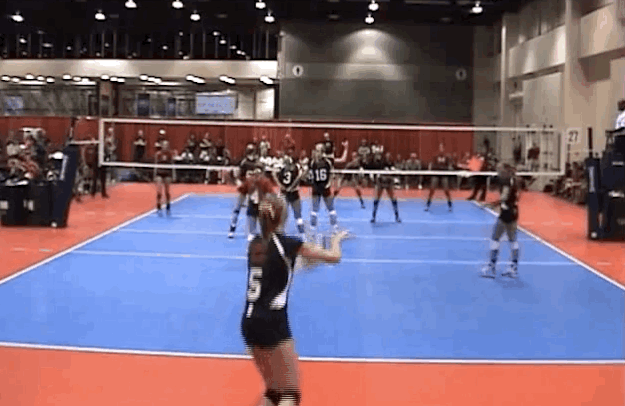
The Nigeria Volley ball Federation was formed in 1970 with Dr. J.C Omoruwa as its first chairman.It is a game played between two teams of 6 players each. It can be played by both sexes.
Basic Skills and Techniques
1. The service (under Arm, Tennis, over head and windmill service).
2. The Volleying
3. Digging
4. Spiking
5. Blocking
6. Set-up
7. Dink shot.
Rules and regulations of the game
1. All matches consists of 3 out of 5 games
2. The choice of court or service is decided by a toss of a coin.
3. Teams change courts after every game or set except in the deciding game when terms change courts at 8 points.
4. The game is started with a service behind the base line.
5. A player is not allowed to play the ball twice, in succession, however a team can play thrice in succession.
6. A ball is out when there is a double foul.
7. A service is retaken if there is a double foul.
8. A game is won when one team leads by 2 points with 25 points aggregate.
Note:- Any team can score a point whether the team is serving or receiving.
Officials and their functions
1.One Referee
2. One Umpire
3. One Scorer
4. Two Linesmen
The Referee
He has authority over players and officials
His decision is final.
He penalizes violations made by players, captains and coaches.
The Umpire
He is the assistant to the referee.
He supervises the rotational order and position of the players
He authorizes substation reputed.
He keep the official time of time – outs.
He notifies the referee of any crossing the centre line.
The Scorer
He keeps the record of the players name and numbers.
He record the scorers.
He notes all time – outs.
He supplies the referee with relevant information at all times.
The Linesmen
They are placed by the base line diagonally opposite each other to watch and indicate with their flags, when the bill is out or in.
Note:- In volley ball game, all line bill is good.
Facilities and equipment
1. The Facilities Are:- The court, the net support and the referee’s stand.
The Equipment Are:- The ball, the net, whistle , score board, score sheets, wear for players.
Court /pitch specification (Dimension)
Court - Rectangular in shape.
Dimension is 18m by 9m .
Height of the net man – 2.43m . woman – 2.24m
Length of front court – 3m.
Length of back court – 6m.

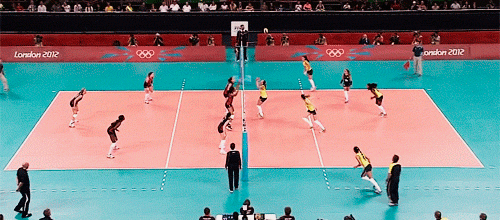
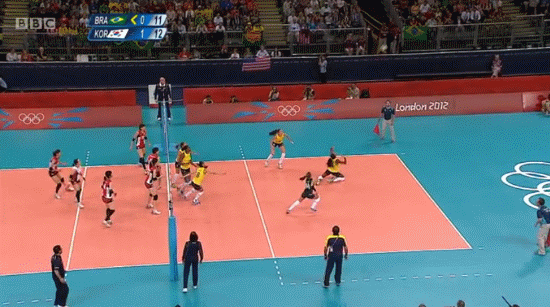
Evaluation :-
1. Who invented volley ball game ?
2. What is the dimension of a volley ball court ?
3. How many players play the game of volley ball ?
Reading Assignment
Essential of PHE for junior secondary school book 1 by Akinseye S.E
Pp 17 – 46
Topic: Ball Games
Content:
(a) Volley ball
(b) History and Development
(c) Basic Skills and Techniques
(d) Rules and Regulations
(e) Officials and their functions
(f) Facilities and equipments (court and dimension)
Volley ball
Volley ball was invented by William Morgan in America in 1895. The International volley ball Association was formed in 1947. Volley ball became an Olympic game 1964 and was first played at the Olympic game in Tokyo, Japan.

The Nigeria Volley ball Federation was formed in 1970 with Dr. J.C Omoruwa as its first chairman.It is a game played between two teams of 6 players each. It can be played by both sexes.
Basic Skills and Techniques
1. The service (under Arm, Tennis, over head and windmill service).
2. The Volleying
3. Digging
4. Spiking
5. Blocking
6. Set-up
7. Dink shot.
Rules and regulations of the game
1. All matches consists of 3 out of 5 games
2. The choice of court or service is decided by a toss of a coin.
3. Teams change courts after every game or set except in the deciding game when terms change courts at 8 points.
4. The game is started with a service behind the base line.
5. A player is not allowed to play the ball twice, in succession, however a team can play thrice in succession.
6. A ball is out when there is a double foul.
7. A service is retaken if there is a double foul.
8. A game is won when one team leads by 2 points with 25 points aggregate.
Note:- Any team can score a point whether the team is serving or receiving.
Officials and their functions
1.One Referee
2. One Umpire
3. One Scorer
4. Two Linesmen
The Referee
He has authority over players and officials
His decision is final.
He penalizes violations made by players, captains and coaches.
The Umpire
He is the assistant to the referee.
He supervises the rotational order and position of the players
He authorizes substation reputed.
He keep the official time of time – outs.
He notifies the referee of any crossing the centre line.
The Scorer
He keeps the record of the players name and numbers.
He record the scorers.
He notes all time – outs.
He supplies the referee with relevant information at all times.
The Linesmen
They are placed by the base line diagonally opposite each other to watch and indicate with their flags, when the bill is out or in.
Note:- In volley ball game, all line bill is good.
Facilities and equipment
1. The Facilities Are:- The court, the net support and the referee’s stand.
The Equipment Are:- The ball, the net, whistle , score board, score sheets, wear for players.
Court /pitch specification (Dimension)
Court - Rectangular in shape.
Dimension is 18m by 9m .
Height of the net man – 2.43m . woman – 2.24m
Length of front court – 3m.
Length of back court – 6m.



Evaluation :-
1. Who invented volley ball game ?
2. What is the dimension of a volley ball court ?
3. How many players play the game of volley ball ?
Reading Assignment
Essential of PHE for junior secondary school book 1 by Akinseye S.E
Pp 17 – 46
WEEK 6
LESSON 7
Topic :- Ball Game (soccer)
Content:- (a) History and Development.
(b) Basic skills and techniques
(c) Rules and regulations
(d) Officials and Regulations
(e) Facilities and equipment
(f ) Court / pitch specification (Dimensions).
History And Development Of Soccer
The true origin of soccer is difficult to determine but soccer otherwise known as football could be linked to the Greeks and Romans. The game was later brought to England by the Romans Soldiers. In 1863,the London Football Association established the first set of rules of the game .The English called it “Association Football”, while the Americas called it “soccer”.
Modern football was brought to Nigeria Football Associations (N.F.A) was established in 1945.The body responsible for the rules of the game is F.1. F.A ie. Federation of International football Association. It was founded in 1904 in Zurich – Sintzer land.
Soccer in an international game played by 2 team of 11 players aside. Substitutes of 7-11 players are allowed depending on the governing body .A player can play the ball with any part of the body except the hand and arms. However, this does not apply to the goal keeper in started with a “ place kick” in the centre circle of a rectangular field having goal –areas, penalty areas, corner areas, and the goals.
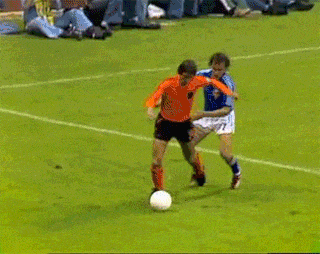
Basic Skill and Techniques
Skill involved in soccer are:.
_ Kicking.
_ Passing.
_ Dribbing
_Throw-in
_Trapping
_Heading
_Tackling.
_Goal-keeping
Rule and Regulations
(a)The 10 Penal Offences are
-Kicking or attempt to kick an opponent
-Tripping an opponent
-Jumping at an opponent
-Changing an opponent dangerously
-Holding an opponent by hand or arm
-Striking or attempt to strike an opponent
-Handing the ball
-Pushing an opponent by hand or arm
-Using offensive, insulting or abusive language
-Tackle an opponent in a dangerous manner
(b) Off-side rule –A player is said to be off-side when he is nearer to his opponents goal line than the ball unless there are two or more defenders (apart from goal keeper) nearer their own goal line than him.
(c) Penality Kick is awarded when any of the 10 penal offences is committed by the defending team inside the “box eighteen”.
(d) Duration of Game;. Two equal periods of 45 minutes each. The interval at half time is 15 minutes
(e)Position of Players.
Number 1:. The goal keeper
2: the right full back
3: the left full back
4: the left half back
5: the centre half back
6: the right half back
7: the outside right
8: the inside right
9: the centre forward
10: the inside left
11: the outside left.
Officials and their functions
-The referee
-Two Assistant referees
-Match Commissioner
-Reserve referee
Referee
1. take full control of the game
2. caution players and keep a record of the game
3. his decision is final
4. act as time keeper and enforces rules and regulation of the game
5. reject unsuitable match equipment.
Assistant referee
Signal to the referees
1. when the ball is out of play
2. when there is a corner
3. when side is entitled to the throw-in
4. when a player is off-side
Facilities and Equipment
A. The field; maximum minimum
Length; 120m 110m
Width ; 90m 75m
B. The ball
C. Players shoes\Boot, jersey, strockings, short, shin guard.
D.Goal Post-Length 7.32m, Height 2.44m
E. Goal Net
F. Technical Equipments-Whistle , Red and Yellow card
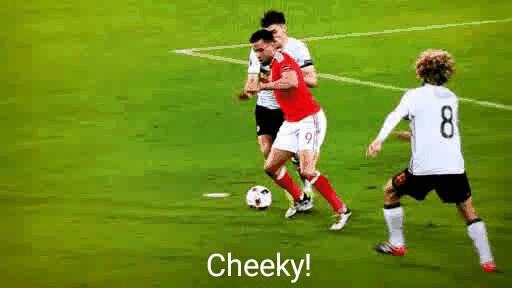
Evaluations
1.What is another name for soccer ?
2. List the eleven player with their full description.
Reading Assignment
Essentials of PHE for Junior Secondary School, book 1 by Akinseye S.E .PP.47-56.
Assignments
1. The Number 1 player in soccer match is called (a) centre man (b) Goal keeper (c) Outside right.
2. One of these is a skill in soccer (a) digging (b) trapping (c) passing
3. How many player makes a team in soccer (a)14 (b) 22 (11)
4. Which one is odd? (a) soccer (b) pole vault (c) volley ball
5. One of these is not a skill in volley ball (a)Trapping (b) Digging (c) volleying
Theories
1. List the 10 penal offences in soccer game
2. When is a player off-side in soccer game
Topic :- Ball Game (soccer)
Content:- (a) History and Development.
(b) Basic skills and techniques
(c) Rules and regulations
(d) Officials and Regulations
(e) Facilities and equipment
(f ) Court / pitch specification (Dimensions).
History And Development Of Soccer
The true origin of soccer is difficult to determine but soccer otherwise known as football could be linked to the Greeks and Romans. The game was later brought to England by the Romans Soldiers. In 1863,the London Football Association established the first set of rules of the game .The English called it “Association Football”, while the Americas called it “soccer”.
Modern football was brought to Nigeria Football Associations (N.F.A) was established in 1945.The body responsible for the rules of the game is F.1. F.A ie. Federation of International football Association. It was founded in 1904 in Zurich – Sintzer land.
Soccer in an international game played by 2 team of 11 players aside. Substitutes of 7-11 players are allowed depending on the governing body .A player can play the ball with any part of the body except the hand and arms. However, this does not apply to the goal keeper in started with a “ place kick” in the centre circle of a rectangular field having goal –areas, penalty areas, corner areas, and the goals.

Basic Skill and Techniques
Skill involved in soccer are:.
_ Kicking.
_ Passing.
_ Dribbing
_Throw-in
_Trapping
_Heading
_Tackling.
_Goal-keeping
Rule and Regulations
(a)The 10 Penal Offences are
-Kicking or attempt to kick an opponent
-Tripping an opponent
-Jumping at an opponent
-Changing an opponent dangerously
-Holding an opponent by hand or arm
-Striking or attempt to strike an opponent
-Handing the ball
-Pushing an opponent by hand or arm
-Using offensive, insulting or abusive language
-Tackle an opponent in a dangerous manner
(b) Off-side rule –A player is said to be off-side when he is nearer to his opponents goal line than the ball unless there are two or more defenders (apart from goal keeper) nearer their own goal line than him.
(c) Penality Kick is awarded when any of the 10 penal offences is committed by the defending team inside the “box eighteen”.
(d) Duration of Game;. Two equal periods of 45 minutes each. The interval at half time is 15 minutes
(e)Position of Players.
Number 1:. The goal keeper
2: the right full back
3: the left full back
4: the left half back
5: the centre half back
6: the right half back
7: the outside right
8: the inside right
9: the centre forward
10: the inside left
11: the outside left.
Officials and their functions
-The referee
-Two Assistant referees
-Match Commissioner
-Reserve referee
Referee
1. take full control of the game
2. caution players and keep a record of the game
3. his decision is final
4. act as time keeper and enforces rules and regulation of the game
5. reject unsuitable match equipment.
Assistant referee
Signal to the referees
1. when the ball is out of play
2. when there is a corner
3. when side is entitled to the throw-in
4. when a player is off-side
Facilities and Equipment
A. The field; maximum minimum
Length; 120m 110m
Width ; 90m 75m
B. The ball
C. Players shoes\Boot, jersey, strockings, short, shin guard.
D.Goal Post-Length 7.32m, Height 2.44m
E. Goal Net
F. Technical Equipments-Whistle , Red and Yellow card

Evaluations
1.What is another name for soccer ?
2. List the eleven player with their full description.
Reading Assignment
Essentials of PHE for Junior Secondary School, book 1 by Akinseye S.E .PP.47-56.
Assignments
1. The Number 1 player in soccer match is called (a) centre man (b) Goal keeper (c) Outside right.
2. One of these is a skill in soccer (a) digging (b) trapping (c) passing
3. How many player makes a team in soccer (a)14 (b) 22 (11)
4. Which one is odd? (a) soccer (b) pole vault (c) volley ball
5. One of these is not a skill in volley ball (a)Trapping (b) Digging (c) volleying
Theories
1. List the 10 penal offences in soccer game
2. When is a player off-side in soccer game
WEEK 7
LESSON 8
Topic ; Pre – Colonial sport/ Traditional sports
Content; (a) Types of traditional sports
(B) Origin and significance of the pre-colonial sports
Types of Traditional sports
They are ;
-Boat Regatta
-Local wresting
-Abula
-Langa

Origin and significance
A. Local wrestling
Traditional or local wresting is one of the oldest sport with history .In past times, ancient men believes that wresting is fit for the gods. Traditional wrestling has various names like Ijakadi, Kokawa, ngba , gidigbo etc. The greatest wrestler in a community is accorded respect in public Places.
Significance
-For recreation ,
-For cultural transmission
-For health live
-For mental alertness
-For entertainment & source of income
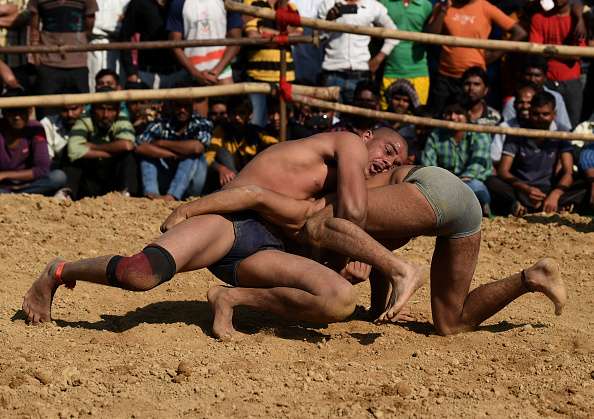
(B) Abula
The game of Abula was invented in 1984 by Elias Yusuf. Abula literally means “cut to join” This is bested on combination of skill of lawn tennis, volleyball and table tennis. The game is played by a uniquely designed Abula bat and a playing court measured 16m by 8m over a net 2.44m high. The game is played by two teams of 4 player each .The game was recognized by the N.O.C. and I .O.C in 1994. It is a regular feature at the biennial national sports festival in Nigeria and the N.U.G.A.
The federal ministry of Education included Abula game in the school curriculum for primary and Secondary Schools in Nigeria in the year 2001.It is simple to established and can be played by both sexes
Significance
- for competition and recreation
- for physical fitness and entertainment
- for fun and enjoyment.
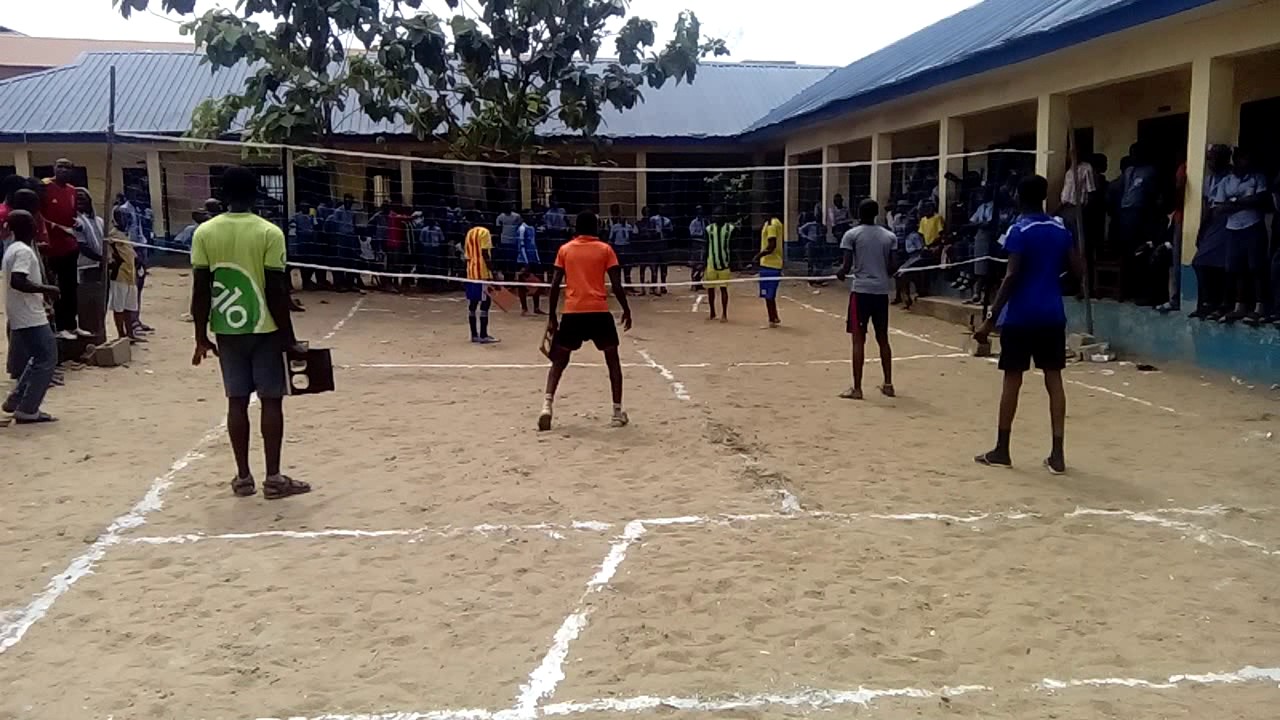
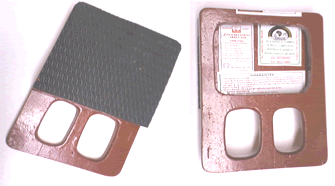
Abula is a ball game invented by Mallam Elias Foluso Yusuf and played with a uniquely designed Abula bat which has built in safety measures.
The game is played in a court of 16m x 8m over a high net of 2.44m from the turf. It is a four aside game with four substitutes allowed on each side, substituting only twice in a set. There are 13 major rules and regulations guiding the game. It is a very popular in schools, clubs and national competitions. It received IOC patronage in 1994 through Sport for All and the Nigeria Olympic Committee.
It is now a regular medal scoring event at the Biennial National Sports Festival in Nigeria scoring 3 gold,3 silver and 3 bronze medals in male, female and mixed doubles categories as recorded at IMO 98,BAUCHI 2000 and EDO 2002.It is recognized by the Nigerian School Sports Federation and NUGA(Nigerian University Games Association) for championship tournaments.
The Federal Ministry of Education has also recognized Abula for the school curriculum in Primary and Secondary schools in Nigeria (2001) Abula was built to be in Montreal Canada at the 4th World Festival of Traditional Sports in 2004.The game was invented in 1984 by Elias Yusuf, basing his invention (of the game) on principle of balanced diet called Abula which has being in existence as old as the civilization of the yorubas in south west of Nigeria.
ADVANTAGES OF ABULA GAME
(i) It is very interesting.
(ii) It is cheap to establish.
(iii) It is simple to understand and master.
(iv) It is very recreative and competitive.
(v) It is for both sex 1.e. for male and female to play together shoulder to shoulder in the same court promoting the spirit of BEIJING 1995.
(vi) It is very popular among school children.
(vii) It is a very safe sport in comparison with some other gruesome sports.
(viii) It economizes space especially in cities where land is a scarce resource.
(ix) It has interesting varieties such as Abula Family Game (AFAGA) and Fitness Abula which are very good for recreational purposes.
RULES AND REGULATIONS OF ABULA GAME
RULE 1(COURT)
It is played in a court of 16m by 8m with a net of 2.44m high in the middle.
RULE 2(BALL AND BAT)
It is played with a tennis size ball and with a specially designed Abula bat. Abula bat weighs between 0.5.kg and 0.75kg.The face of the bat that makes contact with the ball is 20cm by 20cm.
RULE 3
A team is made up of four players aside .Male and female players can play separately. Mixed team of 2 boys and 2 girls are allowed. Four substitutes are allowed per team.
RULE 4
Player’s dress consist of sport vests, shorts/skirts, canvas shoes and socks to match or any other acceptable sport wear/traditional sports wear/jersey.
RULE 5(PLAYING PROCEDURES)
At the start of a match, a toss of the coin decides which side starts the game.
Toss the ball up before you hit the ball with the bat and the ball goes over the net into the opponent’s side of the court, to land inside the court.
RULE 6(SCORING)
You score your points whether you are serving or receiving.
Server serves four times in succession.
The game goes the length of 16 points to win if there is no deuce.
A game goes to twenty points if there is a deuce.
A match is best of three or best of five games.
RULE 7(SERVICE)
A server serves the ball by tossing the ball into the air and hitting the ball with the face of the bat to get the ball over the net to the opponent’s side of the court.
The server serves the ball from the service area at the right hand corner of the back of the court.
Rotation of service is clockwise .The team will rotate when services rotate to them except at the beginning of the game.
DEUCE: A deuce is called at 15-15 .The game then goes to 20 points to win. The first team to get to twenty points wins the game.
During the deuce game, a team will serve once before the service is transferred to the opponent and rotation precedes service.
The player that is serving when the deuce is called starts the deuce game.
RULE 8(BALL AT PLAY)
Three touches are allowed in the game.
RULE 9(BAT MOVEMENT)
Touching the ball in succession by a player is a fault.
Only the face of the bat should be used to contact the ball.
You can use one of the two hands to hold the bat which has three handles in one.
The two hands are also allowed to hold the bat.
Bats of two players of the same team must not hit each other while attempting to play when the ball is in play.
RULE 10(SUBSTITUTION)
There are four substitutes for each team making a total of eight players for the team.
In a mixed team, female substitutes a female (player) while a male for a male (player) respectively.
Only two substitutes are allowed in an encounter/game.
RULE 11(BAT HOLDING)
The bat is held by the handles.
Use only the face of the bat to contact the ball.
RULE 12(OFFICIALS)
Apart from the match commissioner, there shall be eight officials, made up of the followings: One Referee, One Umpire/Assistant Referee, Two Scorers (1 table and one score board), and four linesman. The Referee controls the game with a whistle.
RULE 13(TIME OUT)
A team is allowed a maximum of two time outs in a game.
A time out lasts for 30 seconds.
A change over period between one game and another is two minutes.
FAULTS THAT CREATE POINTS IN ABULA GAME
While playing the ball, if the bats of the two players of the same team touch each other while contacting the ball, the team is at fault,(bat clash or aided contact, it is a fault).
o Touching the ball in succession by a player is a fault. It is double contact.
o Only the face of the bat should be used to contact the ball. Any other part is a fault.
o Out ball is a fault against the last player.
o Block out is a fault against the blocker.
o More than three touches from a side before playing the ball to the opponent’s court is a fault.
o Wrong service is a fault leading to loss of points gained by it through faulty rotation.
o Touching the net with your body or bat when the ball is in play is a fault.
o If the ball hits the bat and the bat hits or touches the ground as a result, it is a fault.
o Throwing the bat to the ball is a fault.
o Backhand play is a fault.
o Ball touching the net directly from a serve is a fault.
o Serving the ball out of court is a fault.
o Faulty service e.g. not being able to serve ball over the net is a fault.
o Serving inside the court is a fault.
o Stepping /overstepping the dividing line of the court is a fault.
(d) Langa
Langa is a popular tradition sport that is commonly found among the Hausa/Fulani ethnic group of the Northern part of Nigeria .It is also played among the Yoruba youths as lakan laka without serious organized competition Langa is gradually spreading to the southern part of Nigeria .It is also a sport that is approved for Primary Secondary School Curriculum by the Federal Ministry of Education.
Langa is one of the earliest celebrated cultural displays among the Hausa speaking communities in northern Nigeria, and famous among the youths between the ages of 10 and 20. The group fighting game is used as a form of entertainment, display of combat prowess among the participating males. Langa game is usually a night event staged in the community arena where the young and old, including young girls come out to watch men in their teens mimic clannish wars to the admiration of the audience.
Participants in the Langa fiesta are usually divided into two equal groups in accordance with the number of people participating. One of the groups would take-off their shirts, leaving the other with their shirts on for identification purpose.
It is after this that the battle line would be drawn, and specific spot would be marked as the target or destination point where the captains of the sides, (Ruwa) as it is called in the game would reach to earn his group a point and that destination is referred to as Sha.
Ruwa is the only person that will determine the completion any round of the game. It is he reaches the Sha (final destination) and wins points for his group or be defeated to the advantage of the opponents.
Defeat in Langa game varies. It could be by Ruwa defeating all members of the opposing group or the Ruwa being able to reach the final destination without being overpowered by the opponent. This marks the end of a round.
Any group that loses all its members during the battle is considered defeated. So also if the group that produces Ruwa loses him during the play, the group is considered defeated. However, losing some members during the game by both groups is not considered a defeat until the end of the round.
The person to be chosen as Ruwa must attain certain qualities. First, he must be strong, bold and skilled in the art to face the opponents as Ruwa while his group members are to provide the necessary backing that would make him reach the destination. The opponents on the other hands are to erect barriers that would prevent the Ruwa from reaching the sha.
It is after this that the real fighting game involving all the group members would ensue. Though it is a make-believe battle, it is usually tough, and participants adopt all strategies, tactics and styles of real battle to ensure that their group emerge victorious at the end of the day, and by so doing the game is made interesting.
The method of fighting is that each member of the two groups would hold one of his legs with one hand and start jumping with one leg while fighting his opponent with the other hand.
Sometimes the game led to infliction of serious injuries on the participating members, but it would never lead to fight between members of the two groups since the entire episode is being considered a game. In fact, it is always starts as a game and ends up as a game.
In those days, the competition is organized among youths of different communities. It was learnt that apart from being a game that is serving as a way of exercising one’s body, it was also promoting unity, friendship and oneness among youths of various communities of Hausaland.
Significance
- for recreational purposes
- for cultural transmission
- for entertainment
- for group activities
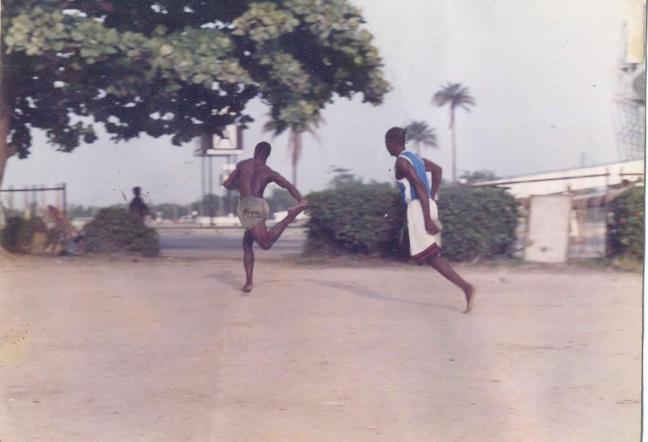
Evaluation;
1.Which year was Abula game invented?
2. Which tribe commonly play langa game ?
3. One of the following game is relevant to Abula game (a)lawn tennis (b) basketball.
Reading Assignment
Essential of PHE for Junior Secondary School Book 1 by Akinseye S.E.PP 62-68.
Topic ; Pre – Colonial sport/ Traditional sports
Content; (a) Types of traditional sports
(B) Origin and significance of the pre-colonial sports
Types of Traditional sports
They are ;
-Boat Regatta
-Local wresting
-Abula
-Langa

Origin and significance
A. Local wrestling
Traditional or local wresting is one of the oldest sport with history .In past times, ancient men believes that wresting is fit for the gods. Traditional wrestling has various names like Ijakadi, Kokawa, ngba , gidigbo etc. The greatest wrestler in a community is accorded respect in public Places.
Significance
-For recreation ,
-For cultural transmission
-For health live
-For mental alertness
-For entertainment & source of income

(B) Abula
The game of Abula was invented in 1984 by Elias Yusuf. Abula literally means “cut to join” This is bested on combination of skill of lawn tennis, volleyball and table tennis. The game is played by a uniquely designed Abula bat and a playing court measured 16m by 8m over a net 2.44m high. The game is played by two teams of 4 player each .The game was recognized by the N.O.C. and I .O.C in 1994. It is a regular feature at the biennial national sports festival in Nigeria and the N.U.G.A.
The federal ministry of Education included Abula game in the school curriculum for primary and Secondary Schools in Nigeria in the year 2001.It is simple to established and can be played by both sexes
Significance
- for competition and recreation
- for physical fitness and entertainment
- for fun and enjoyment.


Abula is a ball game invented by Mallam Elias Foluso Yusuf and played with a uniquely designed Abula bat which has built in safety measures.
The game is played in a court of 16m x 8m over a high net of 2.44m from the turf. It is a four aside game with four substitutes allowed on each side, substituting only twice in a set. There are 13 major rules and regulations guiding the game. It is a very popular in schools, clubs and national competitions. It received IOC patronage in 1994 through Sport for All and the Nigeria Olympic Committee.
It is now a regular medal scoring event at the Biennial National Sports Festival in Nigeria scoring 3 gold,3 silver and 3 bronze medals in male, female and mixed doubles categories as recorded at IMO 98,BAUCHI 2000 and EDO 2002.It is recognized by the Nigerian School Sports Federation and NUGA(Nigerian University Games Association) for championship tournaments.
The Federal Ministry of Education has also recognized Abula for the school curriculum in Primary and Secondary schools in Nigeria (2001) Abula was built to be in Montreal Canada at the 4th World Festival of Traditional Sports in 2004.The game was invented in 1984 by Elias Yusuf, basing his invention (of the game) on principle of balanced diet called Abula which has being in existence as old as the civilization of the yorubas in south west of Nigeria.
ADVANTAGES OF ABULA GAME
(i) It is very interesting.
(ii) It is cheap to establish.
(iii) It is simple to understand and master.
(iv) It is very recreative and competitive.
(v) It is for both sex 1.e. for male and female to play together shoulder to shoulder in the same court promoting the spirit of BEIJING 1995.
(vi) It is very popular among school children.
(vii) It is a very safe sport in comparison with some other gruesome sports.
(viii) It economizes space especially in cities where land is a scarce resource.
(ix) It has interesting varieties such as Abula Family Game (AFAGA) and Fitness Abula which are very good for recreational purposes.
RULES AND REGULATIONS OF ABULA GAME
RULE 1(COURT)
It is played in a court of 16m by 8m with a net of 2.44m high in the middle.
RULE 2(BALL AND BAT)
It is played with a tennis size ball and with a specially designed Abula bat. Abula bat weighs between 0.5.kg and 0.75kg.The face of the bat that makes contact with the ball is 20cm by 20cm.
RULE 3
A team is made up of four players aside .Male and female players can play separately. Mixed team of 2 boys and 2 girls are allowed. Four substitutes are allowed per team.
RULE 4
Player’s dress consist of sport vests, shorts/skirts, canvas shoes and socks to match or any other acceptable sport wear/traditional sports wear/jersey.
RULE 5(PLAYING PROCEDURES)
At the start of a match, a toss of the coin decides which side starts the game.
Toss the ball up before you hit the ball with the bat and the ball goes over the net into the opponent’s side of the court, to land inside the court.
RULE 6(SCORING)
You score your points whether you are serving or receiving.
Server serves four times in succession.
The game goes the length of 16 points to win if there is no deuce.
A game goes to twenty points if there is a deuce.
A match is best of three or best of five games.
RULE 7(SERVICE)
A server serves the ball by tossing the ball into the air and hitting the ball with the face of the bat to get the ball over the net to the opponent’s side of the court.
The server serves the ball from the service area at the right hand corner of the back of the court.
Rotation of service is clockwise .The team will rotate when services rotate to them except at the beginning of the game.
DEUCE: A deuce is called at 15-15 .The game then goes to 20 points to win. The first team to get to twenty points wins the game.
During the deuce game, a team will serve once before the service is transferred to the opponent and rotation precedes service.
The player that is serving when the deuce is called starts the deuce game.
RULE 8(BALL AT PLAY)
Three touches are allowed in the game.
RULE 9(BAT MOVEMENT)
Touching the ball in succession by a player is a fault.
Only the face of the bat should be used to contact the ball.
You can use one of the two hands to hold the bat which has three handles in one.
The two hands are also allowed to hold the bat.
Bats of two players of the same team must not hit each other while attempting to play when the ball is in play.
RULE 10(SUBSTITUTION)
There are four substitutes for each team making a total of eight players for the team.
In a mixed team, female substitutes a female (player) while a male for a male (player) respectively.
Only two substitutes are allowed in an encounter/game.
RULE 11(BAT HOLDING)
The bat is held by the handles.
Use only the face of the bat to contact the ball.
RULE 12(OFFICIALS)
Apart from the match commissioner, there shall be eight officials, made up of the followings: One Referee, One Umpire/Assistant Referee, Two Scorers (1 table and one score board), and four linesman. The Referee controls the game with a whistle.
RULE 13(TIME OUT)
A team is allowed a maximum of two time outs in a game.
A time out lasts for 30 seconds.
A change over period between one game and another is two minutes.
FAULTS THAT CREATE POINTS IN ABULA GAME
While playing the ball, if the bats of the two players of the same team touch each other while contacting the ball, the team is at fault,(bat clash or aided contact, it is a fault).
o Touching the ball in succession by a player is a fault. It is double contact.
o Only the face of the bat should be used to contact the ball. Any other part is a fault.
o Out ball is a fault against the last player.
o Block out is a fault against the blocker.
o More than three touches from a side before playing the ball to the opponent’s court is a fault.
o Wrong service is a fault leading to loss of points gained by it through faulty rotation.
o Touching the net with your body or bat when the ball is in play is a fault.
o If the ball hits the bat and the bat hits or touches the ground as a result, it is a fault.
o Throwing the bat to the ball is a fault.
o Backhand play is a fault.
o Ball touching the net directly from a serve is a fault.
o Serving the ball out of court is a fault.
o Faulty service e.g. not being able to serve ball over the net is a fault.
o Serving inside the court is a fault.
o Stepping /overstepping the dividing line of the court is a fault.
(d) Langa
Langa is a popular tradition sport that is commonly found among the Hausa/Fulani ethnic group of the Northern part of Nigeria .It is also played among the Yoruba youths as lakan laka without serious organized competition Langa is gradually spreading to the southern part of Nigeria .It is also a sport that is approved for Primary Secondary School Curriculum by the Federal Ministry of Education.
Langa is one of the earliest celebrated cultural displays among the Hausa speaking communities in northern Nigeria, and famous among the youths between the ages of 10 and 20. The group fighting game is used as a form of entertainment, display of combat prowess among the participating males. Langa game is usually a night event staged in the community arena where the young and old, including young girls come out to watch men in their teens mimic clannish wars to the admiration of the audience.
Participants in the Langa fiesta are usually divided into two equal groups in accordance with the number of people participating. One of the groups would take-off their shirts, leaving the other with their shirts on for identification purpose.
It is after this that the battle line would be drawn, and specific spot would be marked as the target or destination point where the captains of the sides, (Ruwa) as it is called in the game would reach to earn his group a point and that destination is referred to as Sha.
Ruwa is the only person that will determine the completion any round of the game. It is he reaches the Sha (final destination) and wins points for his group or be defeated to the advantage of the opponents.
Defeat in Langa game varies. It could be by Ruwa defeating all members of the opposing group or the Ruwa being able to reach the final destination without being overpowered by the opponent. This marks the end of a round.
Any group that loses all its members during the battle is considered defeated. So also if the group that produces Ruwa loses him during the play, the group is considered defeated. However, losing some members during the game by both groups is not considered a defeat until the end of the round.
The person to be chosen as Ruwa must attain certain qualities. First, he must be strong, bold and skilled in the art to face the opponents as Ruwa while his group members are to provide the necessary backing that would make him reach the destination. The opponents on the other hands are to erect barriers that would prevent the Ruwa from reaching the sha.
It is after this that the real fighting game involving all the group members would ensue. Though it is a make-believe battle, it is usually tough, and participants adopt all strategies, tactics and styles of real battle to ensure that their group emerge victorious at the end of the day, and by so doing the game is made interesting.
The method of fighting is that each member of the two groups would hold one of his legs with one hand and start jumping with one leg while fighting his opponent with the other hand.
Sometimes the game led to infliction of serious injuries on the participating members, but it would never lead to fight between members of the two groups since the entire episode is being considered a game. In fact, it is always starts as a game and ends up as a game.
In those days, the competition is organized among youths of different communities. It was learnt that apart from being a game that is serving as a way of exercising one’s body, it was also promoting unity, friendship and oneness among youths of various communities of Hausaland.
Significance
- for recreational purposes
- for cultural transmission
- for entertainment
- for group activities

Evaluation;
1.Which year was Abula game invented?
2. Which tribe commonly play langa game ?
3. One of the following game is relevant to Abula game (a)lawn tennis (b) basketball.
Reading Assignment
Essential of PHE for Junior Secondary School Book 1 by Akinseye S.E.PP 62-68.
WEEK 8
LESSON 9
Topic; pre-colonial sport / Traditional Sports(continues)
Contents; Description, facilities, equipment, rules, regulations, techniques and officials of traditional sports.
(a) Local Wrestling (Kokawa)
The play area should be
- on a sandy soil measuring 10 m in diameter
- Duration of play ; 3 rounds of 3 minutes each.
https://youtu.be/9q0G2jZZ1hA
Players Winning
A player miss a bout when the following takes place
- obtain a single majority score
-an opponent surrender by raising up his hand
-by knocking down opponents
Knock Out – this is recorded when an opponent can no longer continue or when he over stays the one minute interval;-
The officials ;- The official are ;- The referee , judges, time keeper, scorer stewards.
Note that the controlling body is Traditional sports Federation of Nigeria.
Abula
https://youtu.be/fp9k5gyCClg
Facilities and Equipment
(a) The facilities are;-
-the court
-the net support
(b) The equipment are;-
- the ball
- the bat
- the net
- the whistle
- the score sheets
- the jerseys
- the canvas
(C)The skills and techniques
- bet holding
-bet movement
- the pass
- the set up
- service (underarm, tennis service)
- receiving
- the retrieving
- the blocking
- the smoking
- the smashing
Note
Either team can score point whether serving or receiving.
A server will continues to serve until his team commit any of the faults in the rules of the game which means that they loss the right to serve .It will be side – out for the other team
A match is won by the team that wins three sets
The officials
A match is conducted by
- the first referee
- the second referee
- one scorer
- two or four lines men
Langa
https://youtu.be/eWjZHQKx_q0
Langa is a one legged game .In this game the contestant holds one leg with his hand.
He supports himself on one leg .This contest involves off-balancing the opponent , forcing him to lose the grip of his foot. Pushing and pulling are allowed , the game can be played either one against one or as a group contact .We only have male category for this game.
Types of Events
There are 3 types of events
- Ruwa (event one)
- Tureshi (event two)
- Kawoshi (event three)
Official
The Referee, umpire, recorded and destination supervisor
Note ;-The controlling body is traditional sports federation of Nigeria
Evaluation;-
1. List 3 equipment of Abula game.
2. What is Knock out Kokawa game?
3. State 5 skills and techniques of Abula game.
Reading Assignment;-
Essential PHE for Junior Secondary School book 1 by Akinseye S.E. pp. 62-68
Assignment;-
1. Find out the meaning of the following
(a) N.O.C
(b) I.O.C
(c) N.W.G.A
(d) T.S.F.N
2.List 8 skill and techniques of Abula game .
Topic; pre-colonial sport / Traditional Sports(continues)
Contents; Description, facilities, equipment, rules, regulations, techniques and officials of traditional sports.
(a) Local Wrestling (Kokawa)
The play area should be
- on a sandy soil measuring 10 m in diameter
- Duration of play ; 3 rounds of 3 minutes each.
https://youtu.be/9q0G2jZZ1hA
Players Winning
A player miss a bout when the following takes place
- obtain a single majority score
-an opponent surrender by raising up his hand
-by knocking down opponents
Knock Out – this is recorded when an opponent can no longer continue or when he over stays the one minute interval;-
The officials ;- The official are ;- The referee , judges, time keeper, scorer stewards.
Note that the controlling body is Traditional sports Federation of Nigeria.
Abula
https://youtu.be/fp9k5gyCClg
Facilities and Equipment
(a) The facilities are;-
-the court
-the net support
(b) The equipment are;-
- the ball
- the bat
- the net
- the whistle
- the score sheets
- the jerseys
- the canvas
(C)The skills and techniques
- bet holding
-bet movement
- the pass
- the set up
- service (underarm, tennis service)
- receiving
- the retrieving
- the blocking
- the smoking
- the smashing
Note
Either team can score point whether serving or receiving.
A server will continues to serve until his team commit any of the faults in the rules of the game which means that they loss the right to serve .It will be side – out for the other team
A match is won by the team that wins three sets
The officials
A match is conducted by
- the first referee
- the second referee
- one scorer
- two or four lines men
Langa
https://youtu.be/eWjZHQKx_q0
Langa is a one legged game .In this game the contestant holds one leg with his hand.
He supports himself on one leg .This contest involves off-balancing the opponent , forcing him to lose the grip of his foot. Pushing and pulling are allowed , the game can be played either one against one or as a group contact .We only have male category for this game.
Types of Events
There are 3 types of events
- Ruwa (event one)
- Tureshi (event two)
- Kawoshi (event three)
Official
The Referee, umpire, recorded and destination supervisor
Note ;-The controlling body is traditional sports federation of Nigeria
Evaluation;-
1. List 3 equipment of Abula game.
2. What is Knock out Kokawa game?
3. State 5 skills and techniques of Abula game.
Reading Assignment;-
Essential PHE for Junior Secondary School book 1 by Akinseye S.E. pp. 62-68
Assignment;-
1. Find out the meaning of the following
(a) N.O.C
(b) I.O.C
(c) N.W.G.A
(d) T.S.F.N
2.List 8 skill and techniques of Abula game .